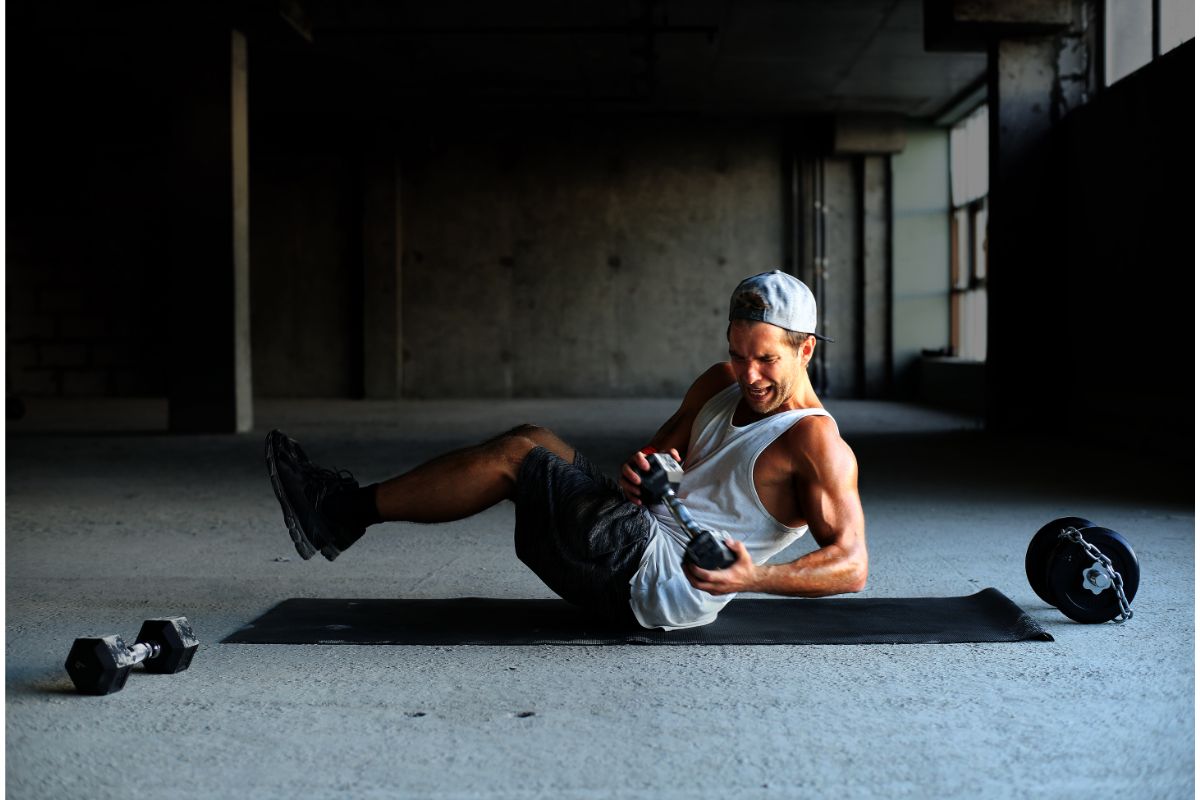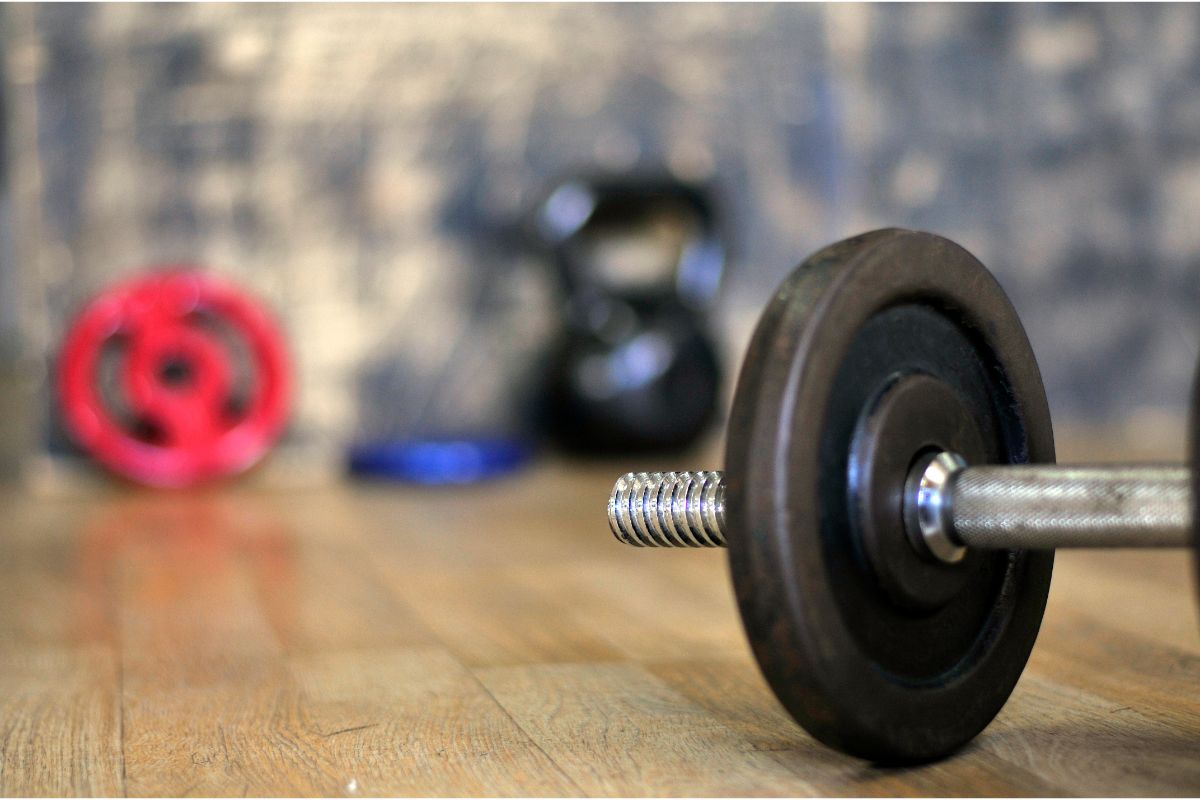Last Updated on December 12, 2022 by TJ Daniels, Certified Personal Trainer
The thought of building muscle can be daunting for many people. You’ve probably seen gym goers use all kinds of equipment when working on their biceps, triceps, abs, and other muscle groups.


But, did you know, that with commitment and consistency, you can build muscle by only using dumbbells? Well, it is possible, but there are certain steps that you will want to follow.
Using dumbbells is an important part of many lifter’s routines. Although small in stature, dumbbells can help you build muscle mass as long as you add weight progressively as time goes on.
The more weights you use, the more challenging it will be for your muscles. Don’t forget, though, that diet is also an essential part of building muscle mass.
That is why you need a caloric surplus and a high protein diet to fuel muscle growth.
If you want to build muscle mass using dumbbells, you’re in the right place. Today, we are going to guide you through the process of building muscle using dumbbells and take a look at how and why this is possible.
As long as you are consistent with your routine, train hard for 20-30 minutes each session, and keep a detailed record of what exercises you do each week, you will soon see and feel gains.
Can You Build Muscle With Dumbbells?
This is a question most beginners ask when looking to build muscle. The good news is, yes, you can build muscle mass with the use of dumbbells.
Ask most trainers who lift, and they will tend to agree that muscle growth is possible with dumbbells.
Of course, the results can differ from one person to another, and how often you train will impact your results. It is important to be aware of the limitations dumbbells have.
Some of these limitations are:
- A limited capacity of weight – it can be hard to build a large amount of muscle, especially in the legs, as these require heavier weights which dumbbells cannot offer
- You typically need a bench – to achieve a full range of motion and to maximize your potential, a bench is always a great asset
- Harder to grip – when weights are heavier on dumbbells, they can be more difficult to hold, especially for beginners
Scientific studies also back up the notion that dumbbells can build muscle. A past study saw 19 men perform bench presses using dumbbells, a barbell, or smith machines.
The fatigue index was then measured for each participant. It was found that those using dumbbells experienced similar levels to those using barbells or weight machines.
Another study used 12 men and put them through the same routine. This time, however, the muscle activity of each man’s chest, shoulders, and arms were measured.
Again, scientists found that the men’s pectoral, deltoid, bicep, and tricep muscles were activated to the same extreme with both barbells and weight machines.
So, as you can see, training experts and scientists back the fact that dumbbells can help with muscle growth.
Building Muscles With Dumbbells – How To Do It
Let’s start building those muscles!
Here are the steps:
Step One
Find a suitable training split. A training split simply means the days you will work out per week. Many kinds of training splits exist, with each one targeting specific muscle groups over different days.
Therefore, each of the muscle groups you target will be worked and rested sufficiently.
The different types of training splits are:
- Push/pull/leg splits (PPL)
- Muscle groups splits
- Full body splits


The PPL split is when you concentrate on pushing your chest, shoulders, and triceps and pulling other muscle groups such as your back, biceps, and abdominals.
This type of split is typically done over 6 workouts every week. Therefore, each muscle group has 48 hours to rest before being targeted again.
Muscle group splits are when you concentrate on just one or a couple of muscle groups every day. For instance, you will target your arms, shoulders, back, and abs on certain days.
This split is usually completed across 5 or 6 days to give each muscle group adequate rest.
Full body splits work all the muscle groups in your body. However, this type of split is cut to 3 or 4 days per week to give each group 24 hours to rest accordingly.
If you have a busy schedule, this is a good option, but each training session typically lasts a little longer. For beginners who are slim and slender, a 3-day full-body split is recommended.
As your body gets used to the new routine, you can then move on to 4 or 5 days of training a week.
Whatever split you opt for, it’s important that you increase steadily every week to progress. Doing so will help promote muscle growth and, with care, you can allow your muscles to rest and not get overworked.
Step Two
The next step is to determine what dumbbell movements you will be performing. By choosing the right movement for your level, you can strengthen your muscles and improve your ability levels.
Over time, you can increase the weight of your dumbbells and, in turn, your strength.
If your dumbbells do not offer enough weight for your strength, you will need to depend on unilateral exercises. These focus on a single arm or leg at a time.
You should also slow down your movements with tempo training and pauses.
Some of the best exercises to perform with dumbbells include:
- Dumbbell squats
- Dumbbell split squat
- Dumbbell Romanian deadlifts
- Dumbbell single-leg hip raises
- Dumbbell floor press
- Dumbbell unilateral lower body exercises
- Dumbbell overhead press
- Dumbbell bent over rows
- Dumbbell bench press
- Movements with your bodyweight
By mixing up your routine with these different exercises, you stand a much better chance of achieving your goals and building muscle mass.
The key, as we always say here at Qwik Fitness, is consistency. Stick to a routine, week in and week out, while also increasing the weights and reps, and you will certainly see your muscles grow.
How Many Exercises Should You Do A Week?
For most people, 4 to 6 exercises every week should do the job. However, always remember to include warm-up exercises into your workout routine to ensure your muscles are ready for your exercises to avoid injury.
4 to 6 exercises tend to be the magic number. Doing this helps you remain focused on your goals and what you need to do.
Do too much and you will burn out and not have the motivation to workout and likely quit. Do too little and you will not see gains, get frustrated, and likely quit working out.
The main goal is to perform enough exercises to stimulate muscle growth. The fun part about working out is you should always be looking for that “sweet spot” where you are working your muscles just the right amount! No one wants to perform reps that aren’t going to add value and no one wants to quit a workout just short of achieving maximum results.
As for how many reps and sets you should do, we recommend performing 4 to 6 sets of 10 to 15 reps for bigger compound lifts.
You can also try 3-5 sets of 15-20 reps to really build your form, stamina, and endurance quickly. But this is when there is an emphasis on proper form and isolation to ensure you aren’t assisting your reps just to get a higher number done.
In Summary
Using dumbbells can help you build muscle mass. No doubt about it! But it all boils down to how consistent you are with your workout routines and the exercises you perform. Listen to your body and experiment with different dumbbell exercises and a variety of reps and sets to find the best program for you.
- How To Start HIIT Workouts [Beginner’s Guide] - May 18, 2023
- How To Sneak A Workout In While Taking Care Of Your Baby - March 17, 2023
- How To Build Your Chest With Dumbbells [Guide] - February 9, 2023








